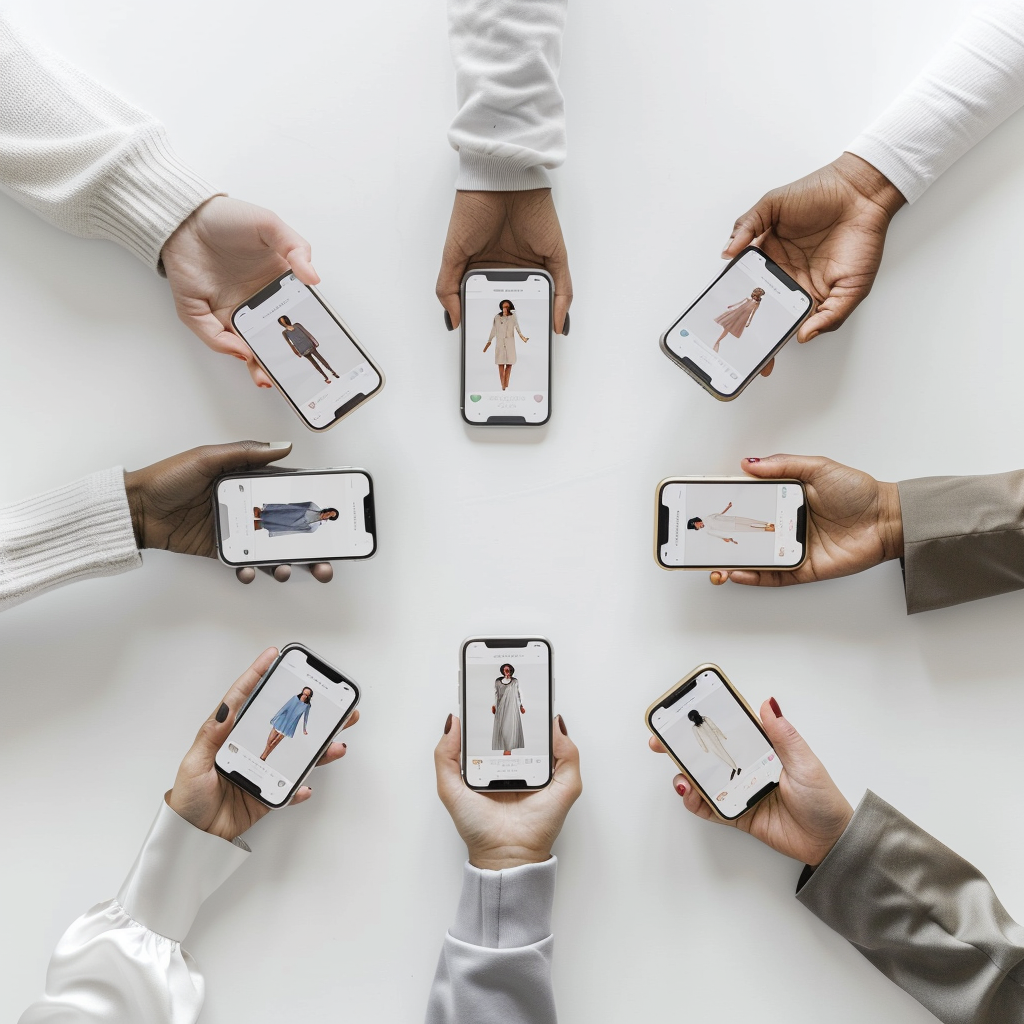
Mobile First Shopping: Personalizing Apparel in the Mobile Era
The dominance of mobile commerce is no longer a forecast; it's the reality. By 2025, nearly 59% of total e-commerce sales are expected to take place on mobile devices, amounting to over $4 trillion in global revenue (SellersCommerce).
In the U.S., the 2024 holiday season saw 53% of online sales come from mobile, marking a new high in mobile-driven purchasing behavior (Adobe).
That growth is accelerating. According to Reuters, U.S. online holiday sales rose nearly 9% year-over-year, fueled in large part by mobile shopping.
The message is clear: shoppers are increasingly browsing and buying from their phones. And with that shift comes a heightened need for brands to adapt the mobile experience, particularly when it comes to fit.
Mobile Commerce Is Booming, but Sizing Remains a Stumbling Block
Despite massive traffic gains on mobile, many apparel retailers face a critical challenge: converting visits into sales. While over 79% of apparel traffic now comes from smartphones, only 68% of purchases are made there (Replo). Cart abandonment rates hover around 85% on mobile, far higher than on desktop.
What’s causing shoppers to bounce?
Fit uncertainty.
Unlike in-store experiences, mobile shopping leaves customers without tactile feedback. They can’t try things on. They rely on size charts that often aren’t optimized for small screens, vary wildly across brands, or are simply too generic to be useful. As a result, shoppers lack confidence.
Some overcompensate by bracketing, ordering multiple sizes, and returning what doesn’t fit. Others walk away entirely, leaving retailers with lost sales, higher return logistics, and weaker margins.
The Legacy of Inconsistent Sizing
Part of the problem isn’t mobile at all; it's the inconsistency in sizing across the apparel industry.
There’s no universal standard. What qualifies as a size “M” or “10” in one brand might be drastically different in another. Vanity sizing, where brands label garments smaller than they truly are to make shoppers feel better, has only made matters worse. Vanity sizing has become so widespread that it has rendered numerical size labels nearly meaningless.
As Forbes notes, this inconsistency creates frustration, damages consumer trust, and leads to elevated return rates across the board.
In a mobile-first world, where decisions are made quickly and distractions are constant, sizing confusion is a conversion killer.
The Rise of Virtual Fit: Eliminating Guesswork on Mobile
To solve this, apparel retailers are embracing virtual fit solutions that take the guesswork out of sizing. Whether powered by artificial intelligence or data-driven algorithms, these solutions are designed to meet the modern shopper where they are: on their phone.
A strong virtual fit experience is:
-
Quick: Delivering personalized size recommendations in under 30 seconds
- Lightweight: Requiring no measuring tapes or photos
- Mobile-friendly: Intuitive enough for small screens
These solutions build shopper confidence, one of the most valuable currencies in online retail, and make the purchase decision easier.
They also reduce bracketing behavior, which has become a significant cost driver for online apparel retailers. As highlighted by McKinsey, sizing-related returns account for up to 70% of total apparel returns.
Personalization and Body Data: Unlocking Competitive Advantage
Beyond conversions, Sizing solutions also provide brands a path to unlock smarter business decisions.
By understanding the real proportions of their customer base, apparel brands can:
- Design better-fitting garments
- Forecast inventory more accurately
- Segment and personalize marketing efforts
This level of personalization, powered by anonymized, statistically accurate data, is becoming a key differentiator in a crowded marketplace.
These advancements represent a significant leap forward from traditional sizing methods, driving not only better consumer experiences but also measurable business improvements.
Leaving Money on the Table: The APAC Opportunity
Nowhere is the mobile commerce boom more powerful or more urgent than in Asia-Pacific. As smartphone adoption accelerates and digital wallets become the norm, APAC leads the world in mobile-first shopping behaviors, with mobile accounting for 74% of total e-commerce traffic (DHL).
The region is also driving a disproportionate share of growth in the fashion and lifestyle sectors. According to Statista, the fashion eCommerce market in APAC is projected to reach over $600 billion by 2026, much of it through mobile. And brands that get the mobile experience right, particularly around fit and personalization, are reaping the rewards.
Luxury and performance brands alike are already seeing results:
- Moncler reported strong Q1 growth in Asia, citing deeper local market engagement and mobile-first digital experiences as key drivers.
- Ralph Lauren continues to double down on China, building regional resonance through personalized customer experiences, localized product fit, and mobile activations.
- The rise of home fitness culture in China is fueling demand for performance apparel, where mobile commerce, personalized fit, and fast returns play a critical role in purchase decisions.
The message is clear: Asia is mobile-first by design and increasingly fit-first by expectation.
Brands that fail to optimize their mobile sizing experience risk:
- Alienating international shoppers who demand speed and accuracy
- Losing out on billions in regional revenue due to cart abandonment and returns
- Falling behind competitors who are investing in personalization at scale
For apparel brands with international ambitions or those already seeing traffic from APAC, this is a critical inflection point. Investing in virtual fit is no longer a backend upgrade; it’s a growth strategy.
The Bold Metrics Difference
At Bold Metrics, we’ve spent the years helping apparel brands solve fit with our AI body data platform that delivers measurable results.
Our platform uses simple shopper inputs like height, weight, and age to create a full-body digital twin, predicting over 50 unique body measurements. This powers highly accurate, style-specific size recommendations that increase confidence and reduce returns.
Here’s what some of our clients have seen:
|
Metric |
Outcome |
|
Conversion Rate |
↑ 4xx on average |
|
Average Order Value |
↑ 22% |
|
Fit-Related Returns |
↓ 18% on average |
Our solutions are optimized for mobile-first environments from UX to speed, ensuring that shoppers get the size information they need, when and where they need it.
Conclusion: Optimizing for Fit in a Mobile-First Future
Mobile isn’t just the future of shopping, it's the present. And with it comes a new set of expectations. Shoppers want speed, personalization, and confidence. They don’t want to take a chance on whether something will fit.
For apparel brands, investing in a virtual fit solution isn’t just about keeping up; it's about standing out. In a world of endless scrolls and abandoned carts, fit is the final frontier of mobile commerce.
At Bold Metrics, we help leading brands meet this moment, empowering them with the solutions to deliver personalized, data-backed sizing that builds trust, drives revenue, and reduces returns.
Ready to see what mobile-first sizing can do for your brand?
Book a demo and start building fit experiences that convert.
SellersCommerce. Mobile Commerce Statistics for 2025 & Beyond. Link
Replo. Ecommerce Conversion Rate by Industry in 2024. Link
Forbes. How Online Retailers Can Reduce Return Rates. Link
Forbes. The Psychology Behind Vanity Sizing. Link
McKinsey & Company. The State of Fashion 2021. Link
DHL. Mobile Commerce in Asia Pacific. Link
Adobe Analytics. Mobile Shopping Expected to Drive 53% of Online Sales During 2024 Holiday Season. Link
Reuters. U.S. Online Holiday Sales Rise Nearly 9%, Mobile Shopping Boom Report Shows. Link
Statista. Fashion eCommerce Market Outlook – Worldwide & APAC Projections. Link
Jing Daily. Moncler Posts Growth in Asia. Link
Jing Daily. Ralph Lauren Deepens Roots in China. Link
Jing Daily. Behind China’s Home Fitness Boom. Link


.png?width=600&height=408&name=march%202023%20-%20french%20toast%20(1).png)

.png?width=1080&height=1080&name=Bold%20Metrics%E2%80%99%20digital%20twin%20technology%20helps%20some%20of%20the%20worlds%20biggest%20bands%20increase%20conversion%20and%20AOV%2c%20reduce%20returns%2c%20optimize%20their%20customer%20experience%2c%20and%20boost%20brand%20loyalty.%20(2).png)






